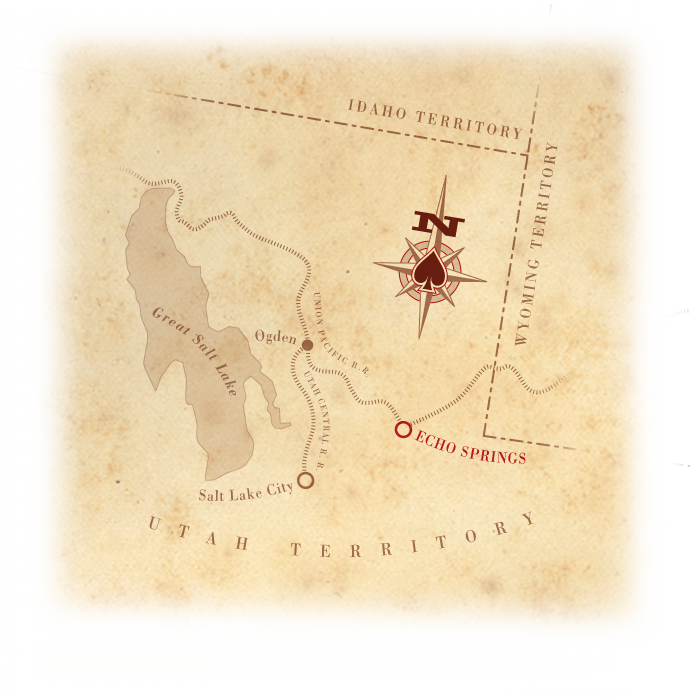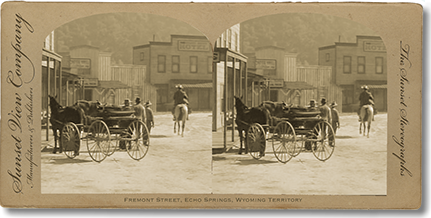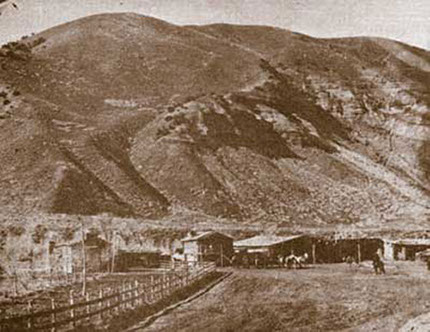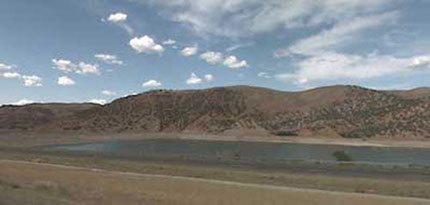







SOURCE REFERENCES
01. Maverick, War of the Silver Kings (1957), Warner Bros. Pictures, Inc.
02. The Conjectural Maverick, Maverick Trails
03. Bennett, Cynthia Larsen, Roadside History of Utah (1999), Mountain Press Publishing Company
04. Fike, Richard E.; Headley, John W., Pony Express Stations of Utah in Historical Perspective, The (1979), Bureau of Land Management, Utah
05. Parry, William T., All Veins, Lodes, and Ledges Throughout Their Entire Depth: Geology and the Apex Law in Utah Mines (2004), The University of Utah Press
06. Echo Reservoir (retrieved 2009), go-utah.com
07. Google Maps, Echo, Utah (retrieved 3/30/2009), maps.google.com
Echo Springs
Silver mining town[1] in Utah Territory[2] in 1870.[1]

ABOVE: Echo Springs, 1870[1]
Situated on the site of a natural spring near the mouth of Echo Canyon, Utah Territory,[2] so named for the echoes heard reverberating off the canyon walls by early Mormon settlers passing through the Rockies on their way to the Great Salt Lake Valley.[3]
James E. Bromley settled at the mouth of Echo Canyon in 1854 to
operate a Funk and Walker Stage Station. He was also Division
Superintendent for the Pony Express’ run from Pacific Springs to Salt Lake City. The station house, known as the Weber or Echo Springs, also acted as general store, inn, saloon, blacksmith shop and jail.[4]
In 1864, John Stoller discovered an outcropping of silver-bearing rock on the hillside southeast of the mouth of Echo Canyon. Word spread, other prospectors began to stake claims on the same hillside, and the mining camp of Echo Springs was established. Though the area’s silver was valuable, the cost of extracting and transporting the ore to market limited the mines’ profits.[2]
Gambling on the revolutionary potential of the coming railroad,
entrepreneur and speculator Phineas King called on geologist and mining engineer William Fennelly in 1866 to survey sites along the proposed railroad route for untapped or previously unaccessible mineral wealth. In 1867, Fennelly found what King was after in Echo Springs.[2]
Based on Fennelly’s survey, King began buying up mines and land in Echo Springs, and staking new claims of his own under the name of the Silver Lady Mine. When the Union Pacific’s first locomotive passed through Echo Springs on January 16, 1869,[3] King had already
established himself as the principal land-owner and businessman of the camp.[2]
Now that heavy goods and equipment could be brought into Echo Springs by rail, King began developing his empire. With Fennelly’s help, he established smelting and milling facilities at the site of the Silver Lady. He contracted the building of a bank in Echo Springs and commissioned the construction of prefabricated buildings to turn the mining camp into a full-fledged town. He opened a hotel, a saloon, and an office building. Soon, other businesses and services came along and Echo Springs became a boom town. By the end of 1869,[2] King’s personal fortune had grown to nearly $5 million.[1]
During the summer of 1870, Bret Maverick organized the four smaller Echo Springs mines of Stoller, Jackson, Lawson and Kreidler, into the New Hope Mining Company to go into combined and aggressive competition with King’s Silver Lady Mine and establish labor reforms amongst the local mining community.[1]
Under Bret’s direction, the New Hope Mining Company began
extracting rich silver ore from veins leading under Phineas King’s claim. Within two months of its creation, the combined mines saw profits of over $600,000.[1]
King fought the New Hope Mining Company in court, claiming that New Hope had no right to mine ore beneath his property. However, Bret invoked the Apex Law, an apparently outmoded, but unrepealed, provision of the Federal Mining Law of 1866[5] that allowed any prospector to follow a surface outcropping, or apex, of a mineral vein on his claim downward wherever it leads, even if under the holdings of adjacent claims.[1]
Based on the merits of the Apex Law, Judge Joshua Thayer ruled in favor of the New Hope Mining Company, which was allowed to continue mining under the holdings of the Silver Lady. King immediately sought legal appeal from the territorial seat in Salt Lake City. While waiting for the decision of the higher court, King had his own mine flooded, which in turn flooded the New Hope tunnels next to his, effectively stopping all mining in Echo Springs.[1]
Knowing Thayer’s ruling would be overturned in the higher court, but
allowing King to believe otherwise, Bret convinced King to merge the Silver Lady Mine with the New Hope Mining Company and retain all the reforms established by the latter. The ruling was indeed overturned in King’s favor, but not before their merger was settled, ensuring better wages and conditions for all miners in Echo Springs, and more eventual profit for King.[1]
By 1878, the silver played out and mining operations were forced to close down. The once-prosperous mining town of Echo Springs began to decline. A small population remained, working mostly for the railroad.[2]
By the end of the 19th century, the region’s industry had shifted mostly to farming. The nearby Weber River was no longer able to support the irrigation demands of agriculture. Water disputes between local farmers became commonplace. Under the direction of Joseph F. Smith, president of the LDS Church, the construction of a reservoir was proposed to supply enough water to irrigate the entire region. Construction finally began on the Echo Canyon Reservoir in 1927 and completed in 1930.[3]
Today, what remains of the town of Echo Springs lies at the bottom of the reservoir,[2] and is the site of excellent boating and water-skiing, as well as decent trout, catfish and smallmouth bass fishing in May and June.[6]


ABOVE: Weber, or Echo Springs, Station in the 1860s.[4]
ABOVE: The site of Echo Springs today. Looking north from I-80, across Echo Reservoir. The mouth of Echo Canyon can be seen to the left.[7]
Home | The Maverick Saga | Trail Maps | Chronology | Maverick Lore | Production | The Inside Straight | Contact Maverick Trails
Maverick Trails is not endorsed, sponsored or affiliated with Warner Bros. Entertainment, Inc. or the Maverick franchise.
Maverick™ and its various marks are trademarks of Warner Bros. Entertainment, Inc., © 1957, 1994
©2014, 2015, 2016 Maverick Trails















